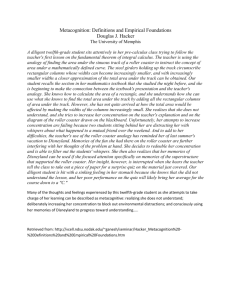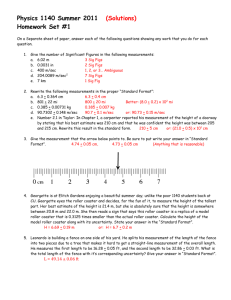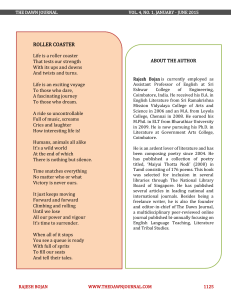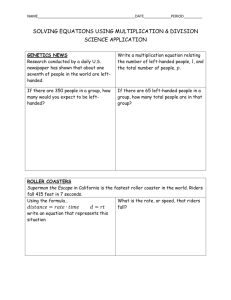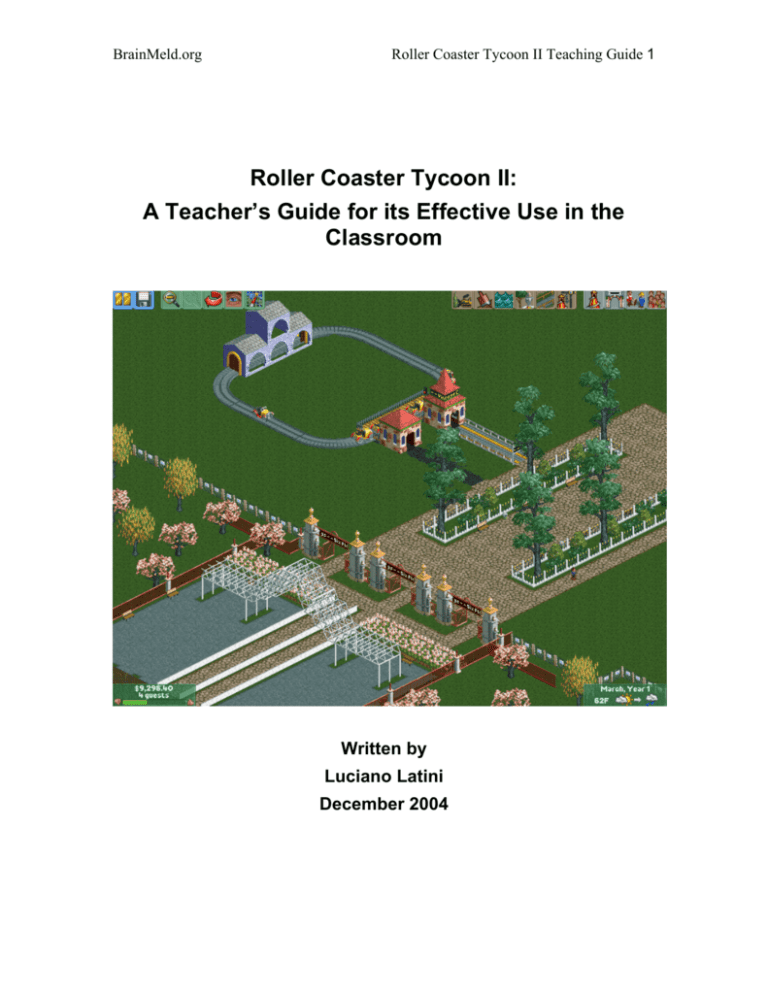
BrainMeld.org
Roller Coaster Tycoon II Teaching Guide 1
Roller Coaster Tycoon II:
A Teacher’s Guide for its Effective Use in the
Classroom
Written by
Luciano Latini
December 2004
BrainMeld.org
Roller Coaster Tycoon II Teaching Guide 2
Table of Contents
Introduction ...........................................................................................................3
About Roller Coaster Tycoon II ................................................................................................... 3
The Importance of Simulations ................................................................................................... 4
Classroom Applications............................................................................................................... 5
Flow of Instruction ....................................................................................................................... 6
Grouping Configurations ............................................................................................................. 7
Standards Addressed.................................................................................................................. 7
Mathematics: Mathematical Reasoning ...................................................................................... 8
Objectives.................................................................................................................................... 8
Before You Start ...................................................................................................9
System Requirements ................................................................................................................. 9
Basic Setup ................................................................................................................................. 9
Overview of Features ................................................................................................................ 10
Lesson 1 –Makin’ the Bucks! ..............................................................................13
Setup ......................................................................................................................................... 14
Activity / Gameplay.................................................................................................................... 14
Follow-Up .................................................................................................................................. 16
Extensions................................................................................................................................. 17
Lesson 2 – Now that you’re a Tycoon… .............................................................17
Setup ......................................................................................................................................... 17
Activity / Gameplay.................................................................................................................... 18
Follow-Up .................................................................................................................................. 19
Extensions................................................................................................................................. 19
Teacher Resources.............................................................................................21
Technical Support / Manufacturer Contacts.............................................................................. 21
Internet Resources .................................................................................................................... 21
California State Standards: ....................................................................................................... 21
Math lesson plan websites: ....................................................................................................... 21
References .........................................................................................................22
About the Author .................................................................................................23
BrainMeld.org
Roller Coaster Tycoon II Teaching Guide 3
Introduction
About Roller Coaster Tycoon II
Roller Coaster Tycoon II is an exciting simulation-strategy game made for the PC
platform involving the construction, organization, and maintenance of a variety of
amusement parks. The game boasts many challenging capabilities, including the
creation of virtually any conceivable roller coaster and thrill ride, terrain
configuration, and even theme parks mirroring actual existing parks such as Six
Flags. Although the game can be suitable for a variety of age groups, its full
potential for learning is really achieved at the middle-school level (7-9th grade)
due to its many higher-level thinking and organizational skill requirements. From
the initial moment of play, participants are involved in a comprehensive
simulation that requires skill, concentration and planning, skills that make the
game highly suitable for educational use. The game’s educational applications
are evident as participants take on the role of Theme Park Tycoon to:
Create countless park scenarios and situations
Generate profits based on expenditures, income, loans, etc.
Assess the value of different variables such as admission fees and
concession pricing
Plan and accommodate for various terrain and land characteristics
during the ride’s construction process
Use laws of physics and motion in planning for ride variables
Hire necessary labor force to support the park and its maintenance
needs
BrainMeld.org
Roller Coaster Tycoon II Teaching Guide 4
Appreciate the need for security and order within a crowded setting
Find ways to increase popular interest
Manage budgets
It is easy to see why Roller Coaster Tycoon II is a natural choice for educational
integration. Students are sure to enjoy the game’s challenges without getting
bored. Little “SIM” People turning green after riding a hair-raising, death-defying
ride does not hurt, either☺!
The Importance of Simulations
It is often said that effective teaching involves learners on a personal level.
Constructivist theory acknowledges the need for learners to arrive at
understanding through personal experience, not simply repeating what is taught
on a linear level. This is where simulations take the learner away from the old,
uneventful teaching styles of yesterday and into a whole new realm of
interactivity and constant adaptation to new situations. Simulations allow the
learner to actually step into a situation and experience first-hand the results of
his/her decisions, without the catastrophic consequences of real-life. As a result,
simulations offer the learner a dynamic, ever-changing environment that includes
the realism of life within an entertaining platform that provides motivation and
incentive for success. Because experimentation can be conducted with
immediate results, learning takes place at an accelerated pace. In Roller Coaster
Tycoon II students can simulate every aspect of an amusement park, right down
to the thrill of riding a mammoth roller coaster (but only after having done lots of
construction, strategizing, and financial planning). In other words, students are
motivated to achieve the end result of the roller coaster experience while they
BrainMeld.org
Roller Coaster Tycoon II Teaching Guide 5
work on complicated problem solving and analysis. Only a simulation can bring
reality and theory together in such an effective way.
Classroom Applications
A common misconception is that video games can only be
integrated within technological applications. Actually, Roller
Coaster Tycoon II can be implemented into many areas of
the curriculum, not just computer-based instruction. Whether
it is used as an independent activity or as an add-on to other
existing activities, Roller Coaster Tycoon II can be utilized within subjects such
as math, science, history, and even art. The simulation, due to its complex and
dynamic game play, is very suitable for cooperative group projects, such as
culminating tasks. Yet teachers can also adapt its use to serve single student or
whole-class instruction, due to its vast flexibility. Here are a few examples:
Small groups of students can collaborate on topics with a competitive
theme, such as designing the most profitable amusement park.
Culminating activities such as essays on results, presentations showing
completed amusement parks to the whole class, and charting of budget
progress can also be modeled in this manner.
Specific sections of the game can be extracted and used for the desired
lesson of the day (example: the budget display to teach about currency
values).
Thematic units on economics, management and mathematics can easily
be created, with Roller Coaster Tycoon II as the testing ground for the
units.
BrainMeld.org
Roller Coaster Tycoon II Teaching Guide 6
Single players can be given certain goals to reach as multi-weekly
assignments that can be worked on at the student’s own pace.
Writing assignments can be based on the many aspects of the game,
such as sequencing of events.
Flow of Instruction
The chronology involved in implementing the game within the classroom will vary
according to individual needs, but the general flow should follow the pattern
below:
Initially, some instruction will be required to cover the game’s many
features and controls (2-3 periods of instructional time).
Practice sessions aimed at achieving dexterity with functions and controls
will follow until most participants feel comfortable with the game (2 periods
of instructional time).
Upon adequate competence, the instructor should present various
activities and goals for the participants to follow. This stage can vary
greatly in time allotment, given the wide range of possibilities. The lessons
presented later in this guide should require about a week’s worth of
instruction to complete (5 periods of instructional time). Of course, projects
such as culminating activities can require an entire semester to complete,
and revolve around a single, yet far-reaching, objective or goal that
participants need to achieve as individuals or as a group.
BrainMeld.org
Roller Coaster Tycoon II Teaching Guide 7
Grouping Configurations
Roller Coaster Tycoon II can be implemented using a variety of classroom
configurations:
Whole Group: Teacher acts as facilitator using a media-sharing device
such as an LCD projector to display, model, and execute various game
activities and functions to the entire class from a single computer.
Discussions, examples, and other follow up activities can then be created
following the lesson for students to work on.
Limited computer access (2-4 computers in the classroom): Students can
take turns or work on a rotational basis within small groups to execute
activities. Students may complete assignments on an individual basis.
Computer Lab – Students can work individually on tasks, and then work
collaboratively to synthesize and present data. Students may also
complete assignments on an individual basis.
Standards Addressed
This guide contains two sample lessons modeled around
Roller Coaster Tycoon II. The lessons effectively address
various California Standards in mathematics for grade 7. The
teacher will soon find that many other state standards can be
BrainMeld.org
Roller Coaster Tycoon II Teaching Guide 8
accommodated by using the simulation.
Mathematics: Mathematical Reasoning
1.0 Students make decisions about how to approach problems:
1.1 Analyze problems by identifying relationships, distinguishing relevant
from irrelevant information, identifying missing information, sequencing
and prioritizing information, and observing patterns.
1.2 Formulate and justify mathematical conjectures based on a general
description of the mathematical question or problem posed.
1.3 Determine when and how to break a problem into simpler parts.
Objectives
Objectives for the implementation of Roller Coaster Tycoon II include:
Encourage the motivational and high-level thinking qualities involved with
video game play.
Give students the experience of financial responsibility.
Allow students to work cooperatively on a long-range goal.
Promote the development of management skills.
Increase awareness of potential consequences associated with unsound
decision-making and events that are unpredictable.
Increase student’s ability to analyze, process and report data gathered
during experimental exercises.
Promote team play among cooperative teams.
BrainMeld.org
Roller Coaster Tycoon II Teaching Guide 9
Before You Start
System Requirements
Before installing Roller Coaster Tycoon II, the following requirements must be
met:
PC platform
Pentium II 300 MHz
64 MB RAM (128 MB recommended)
Windows 98/ME/2000/XP
DirectX 8.1 (NOTE: if the game installer detects that your computer does
not currently have Direct X 8.1 or higher, it will install it for you, so there
will be no need to search online for it or run Windows® updates!)
DirectX-compatible video card
DirectX-compatible sound card
4X CD-ROM drive (8X recommended – most cd-rom drives found in
newer computers are of the 52X speed range)
150 MB hard-disk space (200 MB recommended – again, newer
computers are up to many gigabytes, with I gigabyte = 1000 MB)
All of these requirements may seem low by today’s tech standards, but with
many schools having sub-standard equipment, it is possible for some computers
to still not meet these basic requirements. If in doubt, contact your school’s tech
coordinator to verify your computer’s capabilities.
Basic Setup
Roller Coaster Tycoon II is a game that is relatively simple to set up:
1) Start your version of Windows® (98/ME/2000/XP) and exit all other
running programs.
2) Load the Roller Coaster Tycoon II cd-rom into your cd-rom drive.
BrainMeld.org
Roller Coaster Tycoon II Teaching Guide 10
3) If AutoPlay is enabled, a splash screen will appear (see below). Click on
the install button located on the far left:
4) If AutoPlay is not enabled, double-click on the my computer icon on your
desktop. Find your cd-rom icon, and double-click on it. If that does not
work, double click on the setup icon after double-clicking on the cd-rom
icon.
5) Choose typical installation. The installation process can take 4 to 8
minutes, depending on the speed of your computer and cd-rom drive.
6) Follow the on-screen instructions to complete the installation.
7)
Overview of Features
Like any other unfamiliar activity, both students and teacher need time to get
acquainted with the many controls and features of Roller Coaster Tycoon II. It is
recommended that the instructor some time to acquiring such dexterity prior to
attempting the lessons that follow. There are excellent tutorials found within the
game. They are found in the first splash screen when starting the game. The
beginner’s tutorial provides an excellent overview of features that will prepare
participants for the lessons that follow. The familiarization process can be
conducted in the following ways:
Roller Coaster Tycoon II Teaching Guide 11
BrainMeld.org
Teacher can conduct tutorials to a whole group by displaying game play
using an LCD projector connected to a computer
Students can independently take the tutorials at computer stations, either
individually or in small groups. Groups can then report their experiences to
the rest of the class and compare with other groups
Teacher can display certain game features, such as toolbar functions (see
below) as vocabulary lists, word walls, and other types of displays aimed
at gaining familiarity with the game’s functions.
CAUTION: it may be tempting to copy the game for kids to take home and
practice with – doing so violates the game’s license agreements, so
DO NOT COPY AND DISTRIBUTE THE GAME UNLESS THE PROPER
LICENSES HAVE BEEN PURCHASED FROM THE MANUFACTURER!
Below is a list of important game buttons and their functions:
A. Top-left toolbar:
1)
pause: pauses simulation
2)
save: loads or saves games, displays options, allows screenshots
(the method used to show these icons to you!), quits game
3)
zoom: zooms the landscape view in or out
4)
rotate: rotates landscape in 90-degree clockwise increments
5)
view: toggles between underground views and other invisible modes
6)
map: displays mini-map representation of park and features
BrainMeld.org
Roller Coaster Tycoon II Teaching Guide 12
B. Top-right toolbar:
1)
bulldoze: demolishes landscape features
2)
land: adjusts height and slope of terrain
3)
water: creates lakes, rivers and ponds
4)
scenery: creates decorative items such as gardens and statuary
5)
footpaths: builds walking paths, ramps, etc.
6)
rides: builds new rides
7)
attractions: displays reports for rides
8)
park information: opens park status window
9)
staff: controls the hiring and management of employees
10)
guests: displays information about the park’s guests (really fun!)
C: Bottom-left display:
This toolbar displays the following three types of information (from top to bottom):
1) Finances: shows cash available. Clicking on amount displays the financial
summary window, a detailed account of loan, profit, and charted
information
2) Guest Population: shows number of guests in the park – clicking on
number invokes the guests information window
3) Park Rating: green line that indicates the park’s rating between 0 and
1000 – clicking on rating invokes park rating stats
BrainMeld.org
Roller Coaster Tycoon II Teaching Guide 13
D: Bottom-right display:
Date/Weather/Messages: displays current date, weather conditions, and
important announcements (breakdowns, awards, etc)
Although all of these functions may seem overwhelming at first, rest assured that,
after working with the game’s tutorials mentioned earlier for a few periods, all
buttons and displays become second-nature and very user-friendly!
Lesson 1 –Makin’ the Bucks!
Well, it’s finally time to get to some real work! Due to the game’s heavy reliance
on financial management, the first lesson naturally calls for mathematical skills
and applications as they relate to reasoning and prioritizing information to
achieve a goal. Mathematics are so well incorporated within the game’s very
essence that the student deals with math at every aspect of the game without
even trying, and, has fun doing it! The lesson addresses the following 7th grade
mathematical reasoning standards mentioned earlier:
1.0 Students make decisions about how to approach problems:
1.1 Analyze problems by identifying relationships, distinguishing relevant
from irrelevant information, identifying missing information, sequencing
and prioritizing information, and observing patterns.
1.2 Formulate and justify mathematical conjectures based on a general
description of the mathematical question or problem posed.
1.3 Determine when and how to break a problem into simpler parts.
Roller Coaster Tycoon II Teaching Guide 14
BrainMeld.org
The main objective is to create a park that begins to generate profits.
From this premise, students are exposed to the many variables that can
and do affect this single outcome.
Setup
The tutorial sessions described earlier are required for the students to be able to
address the problem presented in this lesson. There are not many skill
requirements for the lesson other than solid basic computational skills that have
been already presented to students by the seventh grade. The lesson will be
presented to a whole group from a single computer connected to a media
presentation device like an LCD projector. Teacher will start a new amusement
park and raise various concerns during its construction phase that relate to the
activity’s final objective: profit.
Activity / Gameplay
1. Start Roller Coaster Tycoon II and click on Start a New Game. Choose
Electric Fields from Beginner Parks.
2. Begin by showing the Financial Summary by clicking
on the
display. Once the Financial Summary window
opens, point out the simple fact that tickets are generating income, but
that, due to other factors (loan interest, research costs, etc.) the park is
showing a loss (see below).
Roller Coaster Tycoon II Teaching Guide 15
BrainMeld.org
3. Recalling form the tutorial, begin building a simple ride
from the
button.
4. Choose Miniature Railway as your first building project.
5. Point out to the class that each construction aspect such as
bulldozing
, footpaths
, etc. costs money that is deducted from
the park’s budget and contributes to loss of profits.
6. Before long, students will begin to volunteer constructive help as to ways
of decreasing expenditures while increasing income. You can encourage
responses by giving hints to the obvious trends.
7. Teacher can continue suggesting other ways to increase profits, like
building more exciting rides, increasing ticket prices, etc.
8. Once the financial summary begins to show profit, the lesson has reached
its objective. You can now save the park by choosing save
top-left toolbar
the park again later.
from the
if you wish to reference
BrainMeld.org
Roller Coaster Tycoon II Teaching Guide 16
Follow-Up
Once students have grasped the general idea of balancing expenditure with
income, they are presented with the following questions, a different question for
each group, to be worked on in small groups working on computers. Groups will
reflect park job descriptions and consist of an engineer, a troubleshooter, a notetaker, and a financial manager. Groups will then report findings to the entire
class: (students should have access to a computer lab or at least a ratio of 4:1 of
computers in the classroom)
•
How would careful planning of the Miniature Railway’s intended path
help with saving money during the construction phase? (1.1)
•
Which is more frugal: demolishing existing structures to make way for
track, or building around obstacles? Does it depend on the particular
situation, or is your answer applicable to every instance? (1.2, 1.3)
•
How important is it to have entrances and exits to your ride at key
locations of the park? Although the park is new, and there are no other
rides yet, do you think that giving patrons easy access to certain key areas
might increase profits? What does this imply about the planning of sites
for future rides? (1.1, 1.2)
•
Discuss the effect of increasing or decreasing the amount of trains running
on the track at all times on the profits. (1.1, 1.2)
•
List the costs involved with the various construction and addition
possibilities within the game, listing the costs from least to most
expensive. Do you think that having a complete knowledge of all of the
BrainMeld.org
Roller Coaster Tycoon II Teaching Guide 17
costs involved will help in increasing profits during future building phases?
Explain why or why not. (1.1, 1.2, 1.3)
Extensions
There are a variety of activities that can be assigned as supplementary practice:
Students can write an essay summarizing different ways to increase
income and reduce expenditure.
Students can compete in small groups with the objective of creating the
most profitable park within certain guidelines.
Students can create Power Point presentations displaying and charting
out trends in their park’s profit and loss history.
Teacher can encourage students to come up with other situations where
similar dynamics are at play and make connections to real-life scenarios.
Students can create dioramas depicting an amusement park with
different attractions.
Lesson 2 – Now that you’re a Tycoon…
By now you and your students will have gained some confidence in moving about
the game, building rides, and understanding the financial aspects of various
actions. In this lesson students will work with more sophisticated scenarios and
compare new challenges that arise that were not present during the first lesson.
Setup
This lesson requires the skills acquired during the first lesson showing trends and
patterns associated with profit and loss. The teacher will now progress to more
complex park scenarios and compare financial ramifications to earlier park
BrainMeld.org
Roller Coaster Tycoon II Teaching Guide 18
trends. The lesson will once again be presented to a whole group from a single
computer connected to an LCD projector. The objective of the lesson is to show
that, although we are spending more to build more complex rides, the income
they are generating more than offsets the costs, resulting in eventual profits.
Activity / Gameplay
1. Start Roller Coaster Tycoon II. Click on Start a New Game and
Choose Electric Fields from Beginner Parks. You may also load the
game you saved in lesson 1 by choosing Continue Playing a Saved
Game from the second splash screen.
2. Begin to build more advanced rides by choosing the
button. You
can choose from any of the Gentle Rides section, such as the Ferris
Wheel, Merry-go-Round, Rowing Boats, etc.
3. Display the Financial Summary by clicking on the lower-right toolbar
and point out the differences between the last
lesson and this one, such as the higher amounts for the new rides, and
their impact on the overall budget.
4. You may now go to the next category of rides, the ever-popular Roller
Coasters! Because these are expensive rides to implement, the
impact on the budget is more pronounced. As you progress through
the activity, though, you will notice the income increase after an initial
rapid drop in profit.
5. Once you have built the rides, conclude that, even though we are
BrainMeld.org
Roller Coaster Tycoon II Teaching Guide 19
spending more money, the higher costs of the new rides is being offset
by more income being generated by more exciting rides that people
want to experience, resulting in higher ticket sales.
Follow-Up
The students by now have learned some very important lessons about
mathematical observation and the prioritization of information as it relates to a
problem. Students can once again work in the same group configurations
presented in lesson 1 in addressing the following questions:
•
What did you notice when we began building more complex rides? What
happened to our budget? (1.2)
•
Set up two parks, one with only one ride, the other with three exciting
rides. Take careful notes of the budget progress. Which park makes
profits after six months (Park Time)? Which park makes more profits after
two years? What can you conclude about the building of costly rides? (1.1,
1.3)
•
Name three ways to increase long-term profits. (1.2)
•
Which group member had the most important role in decision making
(engineer, troubleshooter, financial manager)? Can the group function
without one or more of the members? (1.1)
Extensions
•
The class can take a field trip to a local amusement park and collect data
relevant to profit and resource allocation. Students can then analyze the
data upon returning to the classroom and present findings.
BrainMeld.org
•
Roller Coaster Tycoon II Teaching Guide 20
Students can extend their learning by showing similar trends of income
and profits within other enterprises by conducting Internet research.
•
Students can write an essay summarizing their experience with the
simulation and how it has changed their view of the financial structure of
business establishments.
In summary, Roller Coaster Tycoon II is a powerful, interactive tool that teaches
kids the important skills of reasoning and identifying relationships within a
problem, all while providing hours of endless fun. The teacher is encouraged to
take the ideas presented in this guide and customize them to his/her needs, such
as different grade levels, subjects, and class configurations. The objective of this
guide is NOT to alter your style of teaching or replace it with unfamiliar content,
but rather to give you a viable alternative to presenting important standard-based
skills in a whole new and exciting manner.
BrainMeld.org
Roller Coaster Tycoon II Teaching Guide 21
Teacher Resources
Technical Support / Manufacturer Contacts
Infogrames Interactive, Inc.
Live Phone Support (24/7 automated response, 8:00 am – 6:00 pm PST live
operator help:
(425) 951-7108 (NOT toll-free)
Fax support:
(425) 806-0480 (NOT toll-free)
24-7 support available on the internet at:
http://www.ina-support.com
Make sure to review the online manual accessible from the splash screen or
within the game. It contains valuable information regarding tutorials, game
features, etc.
Internet Resources
Infogrames websites:
http://www.rollercoastertycoon2.com
http://www.us.infogrames.com
http://www.us.infogrames.com/freebies (lots of downloadable free stuff!!)
http://www.ina-community.com (gamer chat – WARNING: these chat lines are
not monitored – use strong caution around students, as use of chat lines may
violate your district’s Acceptable Use Policies)
California State Standards:
http://www.cde.ca.gov/be/st/ss/
Math lesson plan websites:
http://mathforum.org/library/resource_types/lesson_plans/
http://www.nytimes.com/learning/teachers/lessons/mathematics.html
http://members.ozemail.com.au/~petehobson/
http://www.iit.edu/~smile/
http://www.thirteen.org/edonline/lessons/index.html
BrainMeld.org
Roller Coaster Tycoon II Teaching Guide 22
References
Haugland, S.W., & D.D. Shade. (1999). Software evaluation for young
children. In Young children: Active learners in a technological age, eds. J.L.
Wright & D.D. Shade. Washington, DC: NAEYC.
Atherton J. S. (2003) Learning and Teaching: Piaget's developmental
psychology [On-line] UK: Available:
http://www.dmu.ac.uk/~jamesa/learning/piaget.htm Accessed: 12 December
2004
Milken Exchange on Education Technology. (1999). Will new teachers be
prepared to teach in a digital age? A national survey on information technology in
teacher education. Santa Monica, CA.
Grabe, M., Grabe, C. (2004). Integrating Technology for Meaningful
Learning. Boston, MA: Houghton Mifflin.
Smaldino, S., Russell, J., Heinich, R., & Molenda, M. (2005). Instructional
Technology and Media For Learning. Upper Saddle River, NJ: Pearson Merrill
Prentice Hall.
Copyright Note
(c) 1999 Infogrames Interactive, Inc. All rights reserved. Roller Coaster Tycoon II
teacher's guide may be copied for classroom use only and any other
unauthorized use or copying of any other Roller Coaster Tycoon II materials is
prohibited by applicable law.
BrainMeld.org
Roller Coaster Tycoon II Teaching Guide 23
About the Author
Luciano Latini has been an educator for 17 years with the Los Angeles School
District. Mr. Latini received his BA in Spanish Language and Culture in 1990 from
California State University, Northridge, and graduated Cum Laude. He holds a
California Multiple Subject B-CLAD credential, and is currently serving as
Technology Coordinator for his Los Angeles Unified School District school site.
Mr. Latini owns a consulting business in Los Angeles, California catering to
schools and small businesses for their networking, web development and
troubleshooting needs. Mr. Latini is currently working on a Master’s Degree in
Educational Technology. Having taught in every grade level between K-9th, Mr.
Latini has had vast experience in a wide range of educational approaches, finetuning his skills as a teacher and coordinator.


